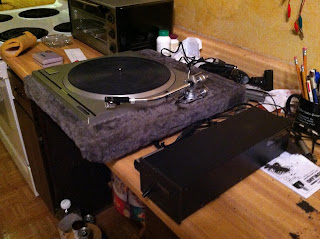He came out to buy a decent Technics table I had listed, mentioned he had a "professional, or broadcast" 'table in the closet, can't remember his exact verbiage, form a local recording studio here in town that went out of business years ago.
Dragged it with him, and it turned out to be a fuzzy dice Technics SP-10 mk II mounted in a custom shag carpet base. It had been mounted in a console at that studio. Not in perfect shape, but everything except one of the tonearm cables was there.
Way cool, had the power supply, remote, a couple of arms, so I gave him the table I had plus some $$$.
Works out this way sometimes, you are selling things but it costs you!
Actually have never had one of these, not a huge direct drive fan (see my earlier posts), but curious to have fun with this.These are famous in their own way, and have a bit of a cult following.
Seems to work fine, will keep you posted.


















